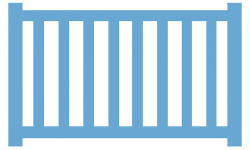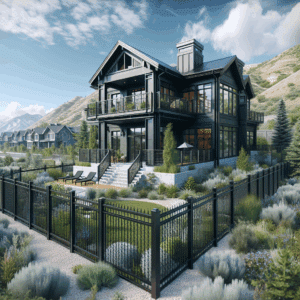Installing a New Fence can be a daunting task for any homeowner, especially with the myriad options available. At Utah Fencing Company, we understand the importance of finding the right fence for your property. That’s why we’ve put together this ultimate DIY guide for installing a Simtek Fence. This guide is perfect for those who want to tackle the project themselves while ensuring a professional finish. Let’s dive into the step-by-step process and get your fence installed like a pro!
Understanding Simtek Fences
SimTek fences are gaining popularity due to their durability and aesthetic appeal. Made from a proprietary blend of recycled materials, these fences offer a stone-like appearance that enhances any property’s exterior. One reason homeowners love SimTek is its ability to withstand harsh weather conditions, which is perfect for outdoor spaces here.
Additionally, SimTek fences boast noise-reduction qualities and require minimal maintenance. This means you can enjoy peace and tranquility in your yard without the constant upkeep of traditional fencing materials. They are the ideal choice for any homeowner looking to combine beauty with practicality.
Gathering the Necessary Tools
Before jumping into the Installation process, you’ll need the right tools for the job. A successful DIY project requires preparation, so let’s start by assembling everything you need.
Begin by gathering essential tools including a post-hole digger, level, tape measure, and a circular saw. Having these tools at your disposal will streamline the process, preventing unexpected trips to the hardware store.
Also, stock up on protective gear like gloves and safety glasses to ensure a safe working environment. The right gear not only protects you but also makes the job more comfortable and enjoyable.
Choosing the Perfect Fence Location
Location, location, location! It’s a crucial step in the fence installation process. Determine where you want your fence to be and mark the boundary lines accurately. This helps in visualizing the finished project and ensures that you stay within your property limits.
Consider the terrain and how it may impact the installation. Uneven ground or obstacles can pose challenges, so plan accordingly to accommodate such factors. By taking the time to select and prepare your location, you’ll avoid potential issues down the line.
Measuring and Marking for Success
Accurate measurements are the cornerstone of any successful DIY project. Start by measuring the perimeter of the area where you intend to install the fence. Use stakes to mark corners and points where posts will go.
Next, run a string between the stakes to outline where the fence will stand. This serves as a visual guide, ensuring straight lines and even spacing. A well-measured layout sets the stage for a smooth and efficient installation process.
Digging Post Holes
Once your layout is marked, it’s time to dig post holes. The depth of each hole is critical for stability, so ensure they’re at least one-third the height of your planned fence. Utilize a post-hole digger to achieve uniform holes.
Bear in mind that soil types vary, which may impact the effort needed. Loamy soil may be easy to dig, while clay or rocky ground can be more challenging. Take your time to ensure each hole is precise and ready for the next phase.
Setting the Fence Posts
Now comes the exciting part—setting your posts! Begin by placing each post into the prepared holes, ensuring they are level before securing them in place. Use a mix of gravel and Concrete to stabilize the posts, providing a durable foundation.
Allow the concrete to cure fully before moving on. Patience at this stage pays off with a strong, long-lasting fence. This crucial step guarantees your fence will stand tall against wind and weather variations.
Installing Fence Panels
With posts securely in place, it’s time to attach the SimTek fence panels. This is where your choice in design truly comes to life! Align each panel between the posts, ensuring they are level and properly aligned. Secure panels using the appropriate screws and brackets.
Be meticulous in checking for level alignment as you progress. It’s easy to skip this step in excitement, but ensuring each panel is level leads to a clean and professional appearance.
Adding Finishing Touches
Now that your panels are up, consider adding gates or accent pieces that complement the overall look. Gates can enhance functionality, providing convenient access points to your fenced area.
Think about any additional design elements you might want, such as post caps or lighting. These finishing touches can enhance your fence’s appearance, adding a touch of personal style to your outdoor space.
Maintenance Tips for Longevity
Regular Inspections: Check your fence periodically for wear or damage. Addressing small issues early prevents them from becoming larger problems.
- Cleaning: Occasionally wash your SimTek fence to remove dirt and debris. A simple hose-down or mild soapy water will keep it looking fresh.
When to Seek Professional Help
While DIY projects are rewarding, sometimes it’s best to call in the professionals. If you encounter any significant challenges or feel out of your depth, our team at Utah Fencing Company is just a call away.
We offer professional installation services, ensuring a seamless process from start to finish. Let us handle the heavy lifting so you can sit back and enjoy your beautiful new SimTek fence.
Discover the satisfaction of a successful DIY project, or let us take the reins for you. Connect with us today at 801-905-8153 or Request a Free Quote.




